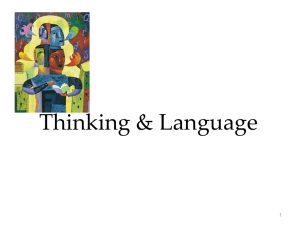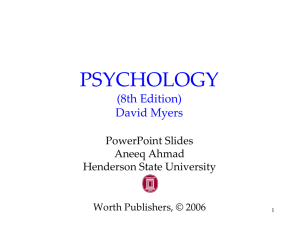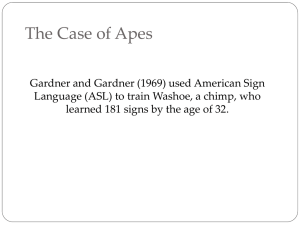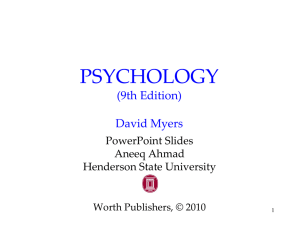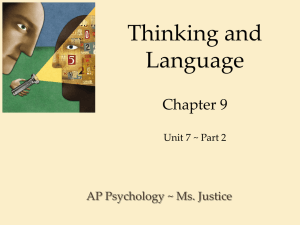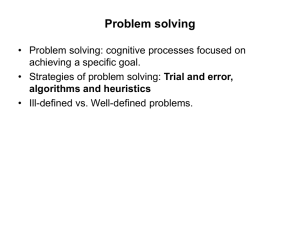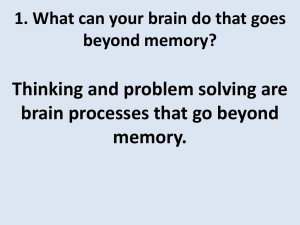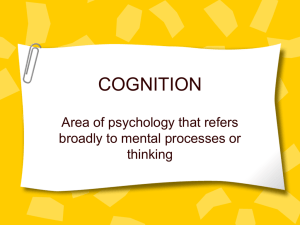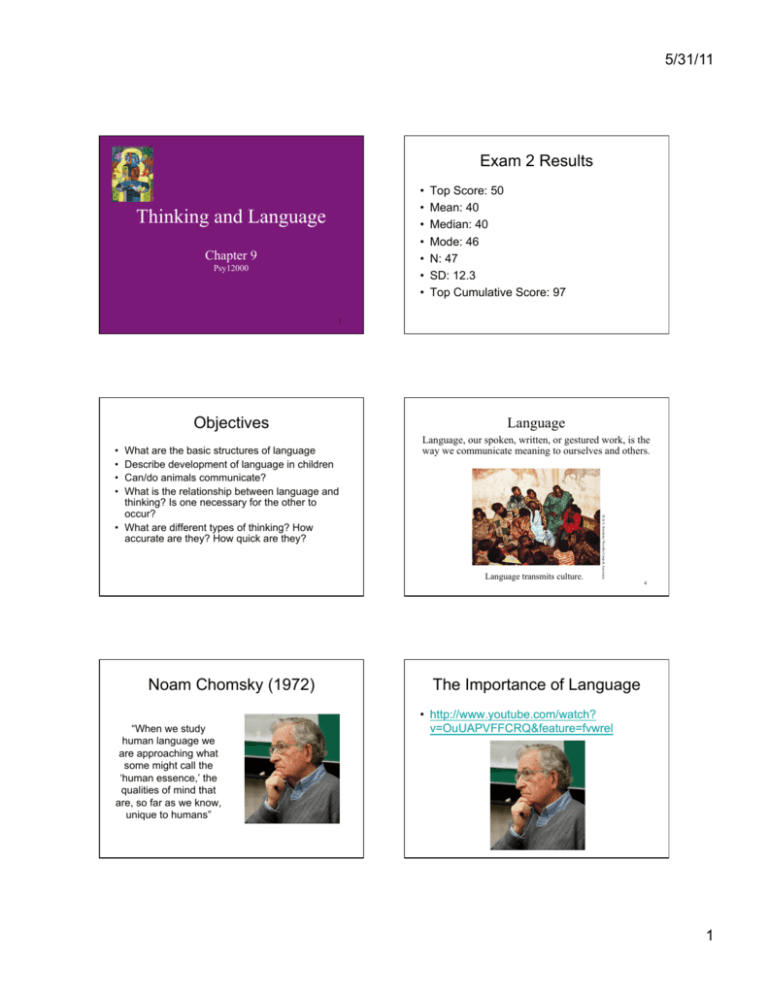
5/31/11
Exam 2 Results
•
•
•
•
•
•
•
Thinking and Language
Chapter 9
Psy12000
Top Score: 50
Mean: 40
Median: 40
Mode: 46
N: 47
SD: 12.3
Top Cumulative Score: 97
1
Objectives
•
•
•
•
Language transmits culture.
Noam Chomsky (1972)
“When we study
human language we
are approaching what
some might call the
‘human essence,’ the
qualities of mind that
are, so far as we know,
unique to humans”
M. & E. Bernheim/ Woodfin Camp & Associates
What are the basic structures of language
Describe development of language in children
Can/do animals communicate?
What is the relationship between language and
thinking? Is one necessary for the other to
occur?
• What are different types of thinking? How
accurate are they? How quick are they?
Language
Language, our spoken, written, or gestured work, is the
way we communicate meaning to ourselves and others.
4
The Importance of Language
• http://www.youtube.com/watch?
v=OuUAPVFFCRQ&feature=fvwrel
1
5/31/11
Recommended YouTube
Videos on Language
Language Structure
Language Acquisition 1-4
• http://www.youtube.com/watch?
v=PZatrvNDOiE&feature=related
• http://www.youtube.com/watch?
v=dsaqD9FVRsM&feature=related
• http://www.youtube.com/watch?v=oimnxkEj4ns
• http://www.youtube.com/watch?v=UTbIG42JoY&feature=related
• Genie: http://www.youtube.com/watch?v=hXeJ6qnsdD4
Phonemes: (phonema [Greek]: a sound uttered)
The smallest distinct sound unit in a spoken
language. For example:
bat, has three phonemes b · a · t
chat, has three phonemes ch · a · t
8
Structuring Language
Language Structure
Morpheme: The smallest unit that carries a meaning.
It may be a word or part of a word. For example:
Milk = milk
Pumpkin = pump . kin
Unforgettable = un · for · get · table
Phonemes
Basic sounds (a bit more than 40 in
English) … ea, sh.
Morphemes
Smallest meaningful units (100,000) …
un, for.
Words
Meaningful units (290,500) … meat,
pumpkin.
Phrase
Composed of two or more words
(326,000) … meat eater.
Sentence
Composed of many words (infinite) …
She opened the jewelry box.
9
10
Grammar
Semantics
Grammar is the system of rules in a language that
enable us to communicate with and understand
others.
Semantics is the set of rules by which we derive
meaning from morphemes, words, and sentences.
For example:
Grammar
Semantics
Semantic rule tells us that adding –ed to the word
laugh means that it happened in the past.
Syntax
11
12
2
5/31/11
Language Development
Syntax
Syntax consists of the rules for combining words
into grammatically sensible sentences. For example:
Time Life Pictures/ Getty Images
In English, syntactical rule says that adjectives come
before nouns; white house. In Spanish, it is reversed;
casa blanca.
Children learn their native
languages much before
learning to add 2+2.
We learn, on average (after
age 1), 3,500 words a year,
amassing 60,000 words by
the time we graduate from
high school.
Earrings Tiny Red Two
13
When do we learn language?
14
When do we learn language?
One-Word Stage: Beginning at or around his first
birthday, a child starts to speak one word at a time and
is able to make family members understand him. The
word doggy may mean look at the dog out there.
Babbling Stage:
Beginning at 4 months,
the infant spontaneously
utters various sounds,
like ah-goo. Babbling is
not imitation of adult
speech.
15
16
When do we learn language?
When do we learn language?
Two-Word Stage: Before the 2nd year a child starts
to speak in two-word sentences. This form of speech
is called telegraphic speech because the child speaks
like a telegram: “Go car,” means I would like to go
for a ride in the car.
Longer phrases: After telegraphic speech, children
begin uttering longer phrases (Mommy get ball) with
syntactical sense, and by early elementary school
they are employing humor.
You never starve in the desert because of all the
sand-which-is there.
17
18
3
5/31/11
Question?
When do we learn language?
Is it through nature or nurture that
we learn how to speak?
19
Explaining Language Development
Explaining Language Development
1. Operant Learning: Skinner (1957, 1985) believed
that language development may be explained on
the basis of learning principles such as
association, imitation, and reinforcement.
2. Inborn Universal Grammar: Chomsky (1959,
1987) opposed Skinner’s ideas and suggested that
the rate of language acquisition is so fast that it
cannot be explained through learning principles,
and thus most of it is inborn.
21
22
Explaining Language Development
Language & Age
3. Statistical Learning and Critical Periods: Well
before our first birthday, our brains are
discerning word breaks by statistically analyzing
which syllables in hap-py-ba-by go together.
These statistical analyses are learned during
critical periods of child development.
Learning new languages gets harder with age.
23
24
4
5/31/11
Another Interview with Noam
Chomsky
Animals & Language
Do animals have a language?
Honey bees communicate by dancing. The dance
moves clearly indicate the direction of the nectar.
http://www.youtube.com/watch?v=fOIM1_xOSro
26
The Case of Apes
Do Animals Exhibit Language?
Chimps do not have a vocal apparatus for humanlike speech (Hayes & Hayes,1951). Therefore,
Gardner and Gardner (1969) used American Sign
Language (ASL) to train Washoe, a chimp, who
learned 182 signs by the age of 32.
There is no doubt that
animals communicate.
Copyright Baus/ Kreslowski
Vervet monkeys, whales
and even honey bees
communicate with
members of their species
and other species.
Rico (collie) has a
200-word vocabulary
27
Teaching Language to
Chimpanzees
28
Gestured Communication
Animals, like humans, exhibit communication
through gestures. It is possible that vocal speech
developed from gestures during the course of
evolution.
Many psychologists study nonverbal and paraverbal
communication
• Video on animal
language
Washoe (1965-2007)
Lucy Temerlin (1964-1987)
See also:
http://www.guardian.co.uk/science/video/2010/oct/13/
chimpanzee-gorilla-vocalisation-body-language
30
5
5/31/11
Sign Language
Computer Assisted Language
American Sign Language (ASL) is instrumental
in teaching chimpanzees a form of
communication.
Others have shown that bonobo pygmy chimpanzees can
develop even greater vocabularies and perhaps semantic
nuances in learning a language (Savage-Rumbaugh, 1991).
Kanzi and Panbanish developed vocabulary for hundreds of
words and phrases.
Copyright of Great Ape Trust of Iowa
Paul Fusco/ Magnum Photos
When asked, this chimpanzee uses
a sign to say it is a baby.
31
Language & Thinking
1. Apes acquire their limited vocabularies with a great
deal of difficulty, unlike children who develop
vocabularies at amazing rates.
2. Chimpanzees can make signs to receive a reward,
just as a pigeon who pecks at the key receives a
reward. However, pigeons have not learned a
language.
3. Chimpanzees use signs meaningfully but lack
syntax.
4. Presented with ambiguous information, people tend
to see what they want to see.
Language and thinking intricately intertwine.
Rubber Ball/ Almay
Criticism
32
33
34
Language Influences Thinking
Language Influences Thinking
Linguistic Determinism: Whorf (1956) suggested that
language determines the way we think. For example,
he noted that the Hopi people do not have the past
tense for verbs. Therefore, the Hopi cannot think
readily about the past.
When a language provides words for objects or events, we can
think about these objects more clearly and remember them. It is
easier to think about two colors with two different names (A)
than colors with the same name (B) (Özgen, 2004).
Benjamin Whorf (1897-1941)
35
36
6
5/31/11
Word Power
Linguistic Determinism Questioned
Increasing word power pays its dividends. It pays for
speakers and deaf individuals who learn sign
language.
Although people from Papua New Guinea do not use
our words for colors and shapes, they still perceive
them as we do (Rosch, 1974).
37
38
Thinking in Images
Images and Brain
To a large extent thinking is language-based. When
alone, we may talk to ourselves. However, we also
think in images.
Imagining a physical activity activates the same brain
regions as when actually performing the activity.
We don’t think in words, when:
Jean Duffy Decety, September 2003
1. When we open the hot water tap.
2. When we are riding our bicycle.
39
40
Language and Thinking
Concept
Traffic runs both ways between language and
thinking.
The mental grouping of similar objects, events, ideas, or people.
There are a variety of chairs but their common features define the
concept of a chair.
41
42
7
5/31/11
Category Hierarchies
Development of Concepts
We organize concepts into category hierarchies.
We form some concepts with definitions. For
example, a triangle has three sides. Mostly, we
form concepts with mental images or typical
examples (prototypes). For example, a robin is a
prototype of a bird, but a penguin is not.
Algorithms
Triangle (definition)
Bird (mental image)
J. Messerschmidt/ The Picture Cube
Daniel J. Cox/ Getty Images
Courtesy of Christine Brune
43
44
Heuristics
Algorithms, which are very time consuming, exhaust
all possibilities before arriving at a solution.
Computers use algorithms.
If we were to unscramble these letters to form a word
using an algorithmic approach, we would face
907,208 possibilities.
B2M Productions/Digital Version/Getty Images
SPLOYOCHYG
Heuristics are simple,
thinking strategies that
allow us to make
judgments and solve
problems efficiently.
Heuristics are less time
consuming, but more
error-prone than
algorithms.
45
Heuristics
46
Insight
Heuristics make it easier for us to use simple
principles to arrive at solutions to problems.
Insight involves a sudden
novel realization of a
solution to a problem.
Humans and animals have
insight.
SPLOYOCHYG
S
PP
SY
LO
CY
HO
OC
LH
OGY
Put a Y at the end, and see if the word
begins to make sense.
47
Grande using boxes to
obtain food
48
8
5/31/11
Fixation
Functional Fixedness
Fixation: An inability to see a problem from a fresh
perspective. This impedes problem solving. Two
examples of fixation are mental set and functional
fixedness.
A tendency to think only of the familiar functions of
an object.
http://www.metacafe.com/watch/621789/
how_do_you_make_4_triangles_with_6_matches/
49
From “Problem Solving” by M. Scheerer. Copyright © 1963 by
Scientific American, Inc. All Rights Reserved.
The Matchstick Problem: How
would you arrange six matches
to form four equilateral
triangles?
?
Problem: Tie the two ropes together.
Use a screw driver, cotton balls and a matchbox.
50
Functional Fixedness
Using and Misusing Heuristics
Use the screwdriver as a weight, and tie it to the end
of one rope. Swing it toward the other rope to tie the
knot.
Two kinds of heuristics, representative heuristics and
availability heuristics, have been identified by
cognitive psychologists.
?
Amos Tversky
Courtesy of Greymeyer Award, University
of Louisville and Daniel Kahneman
51
Courtesy of Greymeyer Award, University
of Louisville and the Tversky family
The inability to think of the screwdriver as a weight is
functional fixedness.
Daniel Kahneman
52
Representativeness Heuristic
Availability Heuristic
Judging the likelihood of things or objects in terms
of how well they seem to represent, or match, a
particular prototype.
Why does our availability heuristic lead us astray?
Whatever increases the ease of retrieving information
increases its perceived availability.
If you meet a slim, short, man who wears glasses and
Probability
that
is a his
truck
driver is would
far greater
likes
poetry,that
what
doperson
you think
profession
be?
than an ivy league professor just because there are more
truck drivers than such professors.
An Ivy league professor or a truck driver?
How is retrieval facilitated?
• How recently we have heard about the event.
• How distinct it is.
53
54
9
5/31/11
Overconfidence
Exaggerated Fear
Intuitive heuristics, confirmation of beliefs, and the
inclination to explain failures increase our
overconfidence. Overconfidence is a tendency to
overestimate the accuracy of our beliefs and
judgments.
The opposite of having
overconfidence is having an
exaggerated fear about what
may happen. Such fears may be
unfounded.
At a stock market, both the
seller and the buyer may be
confident about their
decisions on a stock.
55
AP/ Wide World Photos
The 9/11 attacks led to a decline
in air travel due to fear.
Yet, dying in automobile
accidents is far more probable
than dying in an airplane crash.
56
10


